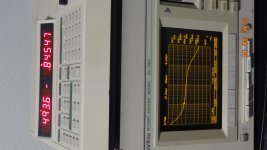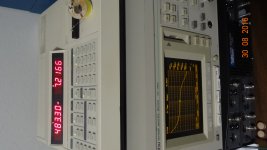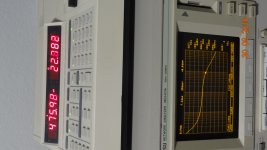Listen to the sound of your 5v regulator through a dac. It flies right through to the output.
The signal which is the difference is a zero integral signal. I suspect it is not viewable when the measurement tool is one that calculates signal power. I discussed this issue a bit with a rather good measurement physicist.
My intent was to put together a pair of IA's to subtract tweeter signals of a bi and mono set. Scott sent me chips I intended to use in my build/test, however the last two years have not been conducive to any hands on work.
John
What are you using now for biwiring that I/others might duplicate and do the test for you?
I have a couple good scope plug-in which might do the job; a TEK 7A22 differential amps and 7A13 diif comparitor.
??
THx-RNMarsh
Listen to the sound of your 5v regulator through a dac. It flies right through to the output.
What?! DAC's without high PSRR?
-RNM
What?! DAC's without high PSRR?
-RNM
Some cheap DAC's use Vcc as their reference, zero PSRR.
In attempts to use SIM and build a passive x-over, the same issue applies as with semiconductor SIMulated circuits. If the parts are not characterized well, you get bad results no matter what the SIM indicates.
An air core inductor, for example, is hard to get 90 degree ideal phase from it over a wide freq range or at least 2 octaves either side of the x-over freq.
Here is some data on a 0.5mH air core inductor pulled from a loudspeaker system. Very typical of all air core values sold for x-over use which I have measured. ---> at 100Hz, 1KHz, and 10KHz. L+Q on top istrument and graph of its phase vs freq below.



8.8 Ohm load.
THx-RNMarsh
An air core inductor, for example, is hard to get 90 degree ideal phase from it over a wide freq range or at least 2 octaves either side of the x-over freq.
Here is some data on a 0.5mH air core inductor pulled from a loudspeaker system. Very typical of all air core values sold for x-over use which I have measured. ---> at 100Hz, 1KHz, and 10KHz. L+Q on top istrument and graph of its phase vs freq below.



8.8 Ohm load.
THx-RNMarsh
Last edited:
Pease ranted about noise on the logic supply line all of the time.What?! DAC's without high PSRR?
-RNM
Listen to the sound of your 5v regulator through a dac. It flies right through to the output.
Presumably your primary focus is on the DAC chip??
What?! DAC's without high PSRR?
-RNM
Unless I've completely misunderstood what I've read aren't the sigma delta dacs a current output from a precision current source and sink? So if the power supply gets through then they are not much of either.
I will find the schematics and post them. You will have to wait a week or two due to my circumstances.What are you using now for biwiring that I/others might duplicate and do the test for you?
I have a couple good scope plug-in which might do the job; a TEK 7A22 differential amps and 7A13 diif comparitor.
??
THx-RNMarsh
John
Hmm. What would that be? I've built and modified a number of DACs where I could change the filter. I did hear some differences, but pretty subtle. Nothing I would rate as clear and distinctive. Maybe your chip has a broader range of control?Having just bought a DAC that permits the loading of three distinct FIR filters, I can say that IF a FIR filter is used, they impart a clear and distinctive sound. Period.
Unless I've completely misunderstood what I've read aren't the sigma delta dacs a current output from a precision current source and sink? So if the power supply gets through then they are not much of either.
Not necessarily. Both Cirrus and AKM have voltage out DAC's using cap filter techniques that push the state of the art. The latest is 127 dB SNR THD+N of -115 dB. Theoretically you need a current out DAC to get more performance but at those levels its hard to see why you would make the effort.
You do need well filtered reference supplies to get the performance.
Back in the early days of DS dacs, Sony, Panasonic, Yamaha etc ran their own in house noise shaping algorithms, and no surprise, they sound substantially different.
Dan.
Dan.
Not necessarily. Both Cirrus and AKM have voltage out DAC's using cap filter techniques that push the state of the art. The latest is 127 dB SNR THD+N of -115 dB. Theoretically you need a current out DAC to get more performance but at those levels its hard to see why you would make the effort.
You do need well filtered reference supplies to get the performance.
I thought the voltage output dacs simply have the integrator built into them rather than external. Maybe you have inside information into the architecture of these dacs which in not shown in the data sheets.
In attempts to use SIM and build a passive x-over, the same issue applies as with semiconductor SIMulated circuits. If the parts are not characterized well, you get bad results no matter what the SIM indicates.
Yes, and I would think that the major hangup would be correct modelling of a speaker. As far as I know there are no sim models for speakers that come remotely close to the accuracy of the C and L and even active device models. In that sense, sims of passive xovers are pretty useless except for a very, very rough proof of concept.
Jan
Quality and expense are relative things. If you want to tri-amp DSP crossovers using DAC-2s, it costs about $1k/output. So if you need 6 DAC outputs that would add up to about $6k. Cheap for some, expensive for others.
Also, if you want to do DSP crossovers, you can't avoid digital filters. Some sound different than others for various reasons, and not are all equally accurate, if accuracy if the goal.
This is DIY audio, so I was referring to DAC chips. You don't need to pay $1000... Nowhere near, if you DIY it.
Digital filters sound like you design them too. Of course filters do have a "sound" - they are designed to alter the sound by.. filtering. You can design them for accuracy - or pretty much whatever you want. But the sound is imparted by the system design, nothing else.
This is DIY audio, so I was referring to DAC chips. You don't need to pay $1000... Nowhere near, if you DIY it.
Digital filters sound like you design them too. Of course filters do have a "sound" - they are designed to alter the sound by.. filtering. You can design them for accuracy - or pretty much whatever you want. But the sound is imparted by the system design, nothing else.
I understand your points, but I don't think a DIYer could design and develop a top quality state of the art DAC for only the cost of a bag of components. As a practical matter, one would need a well equipped lab with state of the art test equipment. By the time all is said and done, the DIY cost of design and development and testing something equivalent to a DAC-2 would probably be much more than just going out and buying one.
If I am wrong and some DIYer can design a DAC of that caliber for cheap, then by all means publish it here and everyone will have good cause to be very happy.
I don't see why you need such expensive DACs on a DSP active crossover either.
Some people are quite happy with cell phones and ear buds. Then don't "need" anything more. Other people want state of the art everything and think it matters. In the end, it's all opinion as to what is good enough for someone's particular purposes.
- Status
- Not open for further replies.
- Home
- Member Areas
- The Lounge
- John Curl's Blowtorch preamplifier part II